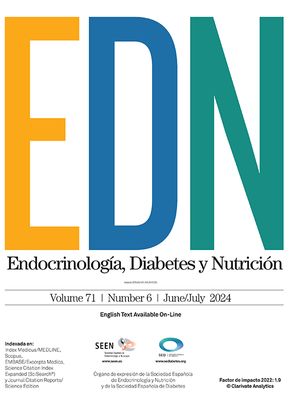The BRAFT1799A mutation is reported to be associated with aggressive, persistent, and recurrent tumor in patients with papillary thyroid carcinoma (PTC). The association of the BRAFT1799A mutation in the primary tumor with the clinicopathological characteristics of PTC was analyzed.
Patients, materials, and methodsNinety-seven PTC patients were followed up for a median of 64.1 months. The BRAFT1799A mutation was analyzed in DNA from initial thyroidectomy biopsies by PCR amplification and restriction fragment length polymorphism using the TspRI enzyme. Positive results were confirmed by DNA sequencing. The statistical association of the BRAFT1799A mutation and clinicopathological characteristics was analyzed using the relevant hypothesis tests and logistic regression.
ResultsThe BRAFT1799A mutation was found in 46.4% of patients. Bivariate and multivariate analyses showed the mutation to be only associated with age over 60 years (odds ratio [OR]=5.5; 95% confidence interval [CI], 1.4–21.9; p=0.019) and to a tumor size of 1cm or greater (OR=3.6, 95% CI, 1.2–10.3; p=0.016). The mutation was not associated with histological subtype, metastasis, recurrence, more aggressive treatments (131I ablation therapy or other surgery), or PTC persistence at the end of follow-up.
ConclusionsThe BRAFT1799A mutation is associated with age over 60 and a tumor size of 1cm or greater, but not with other clinicopathological characteristics, tumor recurrence, or PTC persistence.
La mutación BRAFT1799A se ha relacionado con características tumorales de más agresividad, recidiva tumoral y persistencia de carcinoma papilar de tiroides (CPT), aunque no todos los estudios apoyan esta asociación. En éste, se analiza la asociación entre la presencia de la mutación BRAFT1799A en el tumor primario de pacientes con CPT y las características clinicopatológicas de riesgo, recidiva y persistencia tumoral.
Pacientes, material y métodoHemos seguido a 97 pacientes intervenidos de CPT durante una mediana de 64,1 meses. La mutación BRAFT1799A se determinó en ácido desoxirribonucleico procedente de muestras de la tiroidectomía inicial mediante amplificación por PCR del exón 15 del gen braf y análisis de los fragmentos de restricción con la enzima TspRI. Los casos positivos fueron confirmados por secuenciación. La asociación estadística entre la mutación BRAFT1799A y las diferentes variables se estudió mediante los correspondientes tests de contraste de hipótesis más regresión logística.
ResultadosEl 46,4% de los pacientes eran positivos para la mutación BRAFT1799A. Tras análisis bivariante y multivariante, la mutación BRAFT1799A sólo se asociaba con edad superior a 60 años (odds ratio [OR]=5,5; intervalo de confianza [IC] del 95%, 1,4–21,9; p=0,019) y tamaño de 1cm o superior (OR=3,6; IC del 95%, 1,2–10,3; p=0,016). No se asociaba con subtipos histológicos, metástasis, recidiva, necesidad de nuevos tratamientos ablativos con I131 o de otras intervenciones quirúrgicas debidas a la aparición de metástasis o persistencia de enfermedad al final del seguimiento.
ConclusionesLa mutación BRAFT1799A está asociada a edad superior a 60 años y tamaño tumoral de 1cm o mayor, pero no con otras características clinicopatológicas, recidiva tumoral o persistencia de enfermedad.




